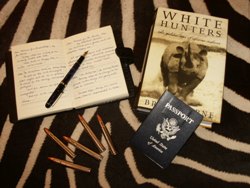

 The Accurate Reloading Forums
The Accurate Reloading Forums  THE ACCURATE RELOADING.COM FORUMS
THE ACCURATE RELOADING.COM FORUMS  Hunting
Hunting  Hunting Reports - Africa
Hunting Reports - Africa  Namibia, Vaughn Fulton's Classic Safari's Elephant Hunt
Namibia, Vaughn Fulton's Classic Safari's Elephant HuntGo  | New  | Find  | Notify  | Tools  | Reply  |  |
| One of Us |
My hunt with Vaughn Fulton's Classic Safaris came about as the result of a thread here on AR last year. I was very impressed with Vaughn's response to a problem which arose with a client and his willingness to take full responsibility for it, make it right and apologize. That is what character is about, and character is a fine attribute for a ph and a businessman. He and I emailed back and forth, and the result was a 16 day elephant hunt on the Salambala Conservancy in the Caprivi Strip, Namibia. The cost for this trip was $1000USD/day for 16 days, with $11,500USD trophy fee for elephant, and other animals available after the elephant hunt for trophy fees. I used Gracy Travel for this trip because I wanted to fly Atlanta to Frankfurt to Windhoek and avoid the possibility of having to fly to Dulles followed by the long flight to RSA, clearing guns in RSA and flying on to Windhoek. The flight was around $2600USD round trip to Windhoek. In addition, there was about a $1600USD charge for an internal round trip flight from Windlhoek to Katima in Caprivi. Because of my trip to Tanzania last year, I had my personal gear fairly well sorted out; however, several key pieces of equipment had to be changed. First, I would have to use larger bore rifles and, second, my cameras had to be changed because the two I had used were broken. Later, I found out I had to change shoes because my trusty Rockports died. Fortunately, I was able to break in two new pair of shoes before the trip as I worked on my personal conditioning for the trip. I replaced my Fuji S-5000 digital camera with a new Fuji S-5200, and my old faithful Sony Hi-8mm camcorder with a newer model of the same type. Unfortunately, the new model does not have a color viewfinder which I really miss. Both cameras worked well on the trip, although the lack of a color view finder makes rapid identification of animals in the field difficult. I had problems with the development of loads for my 416 Howell and 425 Express as many of you may remember from my panicked posts just before I left; however, I managed to get both of the sorted out before departure, and they both worked very well. The 425 Express sported a 2.5X fixed power Weaver scope and the 416 Howell had express sights. I intended to use the 416 for elephant and the 425 Express for plains game if the opportunity presented itself, but had plains game loads for the 416 and solids loads for the 425 in case it had to be used for elephant. The solid load for the 416 Howell was a 400gr Dead Tough in a Norma case with 75gr of 4320 and a WW magnum primer. The soft point load for the 416 Howell was a 400gr Nosler Partition with the same charge, primer and case. The solid load for the 425 Express was 73gr of IMR 4895 under a 400gr old style Barnes solid, and 75gr of IMR 4895 under a 350gr old style Barnes X bullet. Both loads were in Quality Cartridge cases. I found to insure proper function, I had to resize the 425 cases prior to initial loading. In the 416, I found that I had better results taking the stem out of my resizing die and leaving the neck really tight, and then re-installing the stem and expanding the neck slightly (belling the neck) to facilitate seating the bullet. Both loads in both guns were tuned to shoot to the same point of impact at 50 yards. I would like to thank Terry Carr for his load list which I used to check and double check my preparations. I commend this to anyone planning a safari. I also want to thank my gunsmith, Walt Sherman, for fine tuning the 416 Howell, which he built for me some years ago, immediately prior to this trip, and Savage Arms Company for so quickly mailing me a bolt head retaining pin for my 425 Express. Both of these rifles were “broken†on Thursday the week before I was to leave and their efforts save my trip. Debbie Gracy made the flight arrangements with Lufthansa and Air Namibia to leave Atlanta on August 11, fly to Frankfurt and then to Windhoek. I made arrangements in Frankfurt to spend the day at a Holiday Inn Express. This gave me a chance to sleep, take a bath and have a really great lunch at a real German Gasthaus. Just before I was to leave, Air Namibia (AN) advised Debbie that my flight from Windhoek to Katima on the 17th had been canceled. I had made arrangements to tour the coast and fish a couple of days before my hunt began, having regretted not seeing the fabled dunes and desert when I was in Namibia in 2000, and to give myself a couple of days to acclimate and get over the jet lag. This AN change threatened to wipe that opportunity out and put me in camp three days early, which was unacceptable. 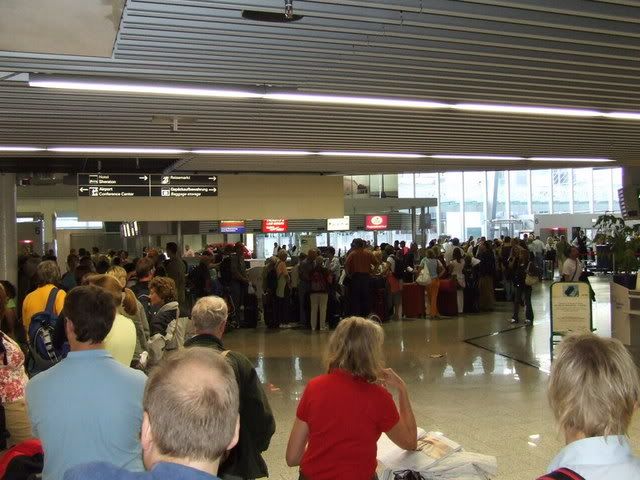 Debbie worked with Classic Safari and it was eventually arranged for a charter up north. I was to fly north with Vaughn's wife, Patricia, and the plane would bring the hunter that was in camp, Travis Chambers, south. Although Travis and I had never met, he is from Lakeland, FL, also went to FSU, and Charlie Goldenberg also arranged a hunt for him in Tanzania last year. It is a small world. In any event, the charter permitted me to stick to my plan to go to Swakopmund and tour south down to Shadow Bay, take a desert canyon tour and go fishing.  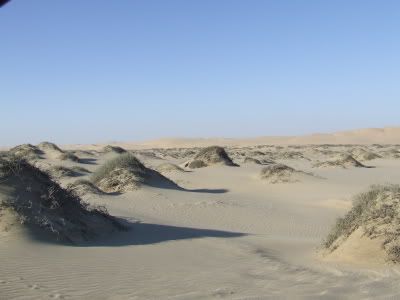 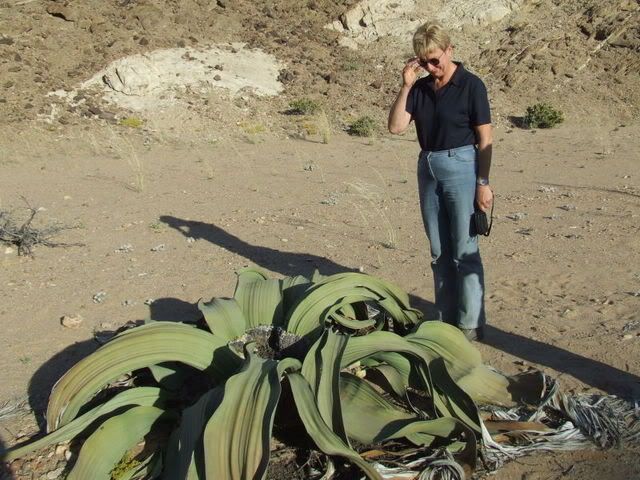  Although we did not get all the way to Shadow Bay because the tide covered up the road, we did have a wonderful excursion over the dunes. The canyon tour was equally beautiful and informative. The fishing trip began, but was terminate after about two hours because of gale warnings, but I strongly recommend these side trips and the fishing if you can make the time. I stayed at the Hotel Eberwein in Swakopmund, which was delightful and the staff there were incredibly helpful in arranging the tours and fishing for me and facilitating the arrangements we were making for the charter flight. 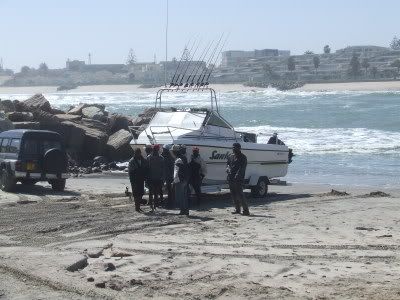 I left Swakopmund early on the 17th, and drove to Windhoek's Eros airport where I turned in my Avis car, and Classic's other ph, Gert Van der Walt, picked me up and took me the couple of blocks to the airport. There I met Patricia Fulton and together we cleared security just like we were on a regularly scheduled flight, boarded a Cherokee 230, and prepared to make our way 600 miles north to Katima. I learned later that the plane was suppose to be a big Cessna; however, this charter was to be real adventure, and the most dangerous part of my safari in my opinion. Because of various reasons, our planned departure at 12 noon was after 1:30pm. The 150mph Cherokee which was substituted for the 200mph Cessna meant that at its best speed the Cherokee would arrive just at dark in Katima. We had a very full load with me, all my gear, the pilot, who was a large man, and Patricia and her one bag. Although Patricia might weigh 80 pounds soaking wet, we had 600 pounds plus of gear and passengers in addition to a full fuel load. My Cabela's aluminum gun case was stuck into the rear of the fuselage and rode over the rear passenger seat next to Patricia and right behind the pilot, and about half way up, the pilot asked me to move my seat forward to improve the A/C's trim. For the first part of the flight, I was content to look at the remarkable landscape as we flew northeast. Soon after we left, the pilot reported we were encountering 20kt headwinds. At about the time we crossed into Botswanan airspace, I was given an 8.5x11†piece of paper with our flight plan on it in order to compare with roads we could identify on the ground. This chart had on it an outline of Botswana, several of the alternate landing fields, our flight path and grid of longitude and latitude. Bored, I began to chart our progress based upon the read out of longitude and latitude on the GPS. It soon showed a flight path that was diverging from our intended line of flight, and diverged more to the west as the plane turned. I showed this to the pilot, who indicated that I must be wrong; however, he checked his position and checked several other readouts from the GPS and reported we now were encountering 38kt headwinds! Our ground speed was below 100mph, and we were over two hundred miles from our destination, and it was after 4:30pm. We were not going to make Katima before dark. The pilot called Katima Tower and got no answer. He called Gaborone Control and asked them to call Katima Tower, which they did, and they got no answer. At this point, he had to consider alternative lighted fields we could use. The only one which was lighted, had customs and immigration control, and was within range was Maun; therefore, he had to declare an in-flight emergency and divert to Maun. The flight to Maun was directly into the teeth of the wind, and as I watched first the left wing-tip tank, the the right, run dry and the right main drop below five gallons remaining, we flew on through the gathering darkness using the ten gallons left in the left main tank. The plane, which burned 15 gallons per hour, was running out of gas based upon the gages. We had an hour's flying time to Maun and an hour's fuel it appeared. I looked out the window and the last light showed what appeared to be a mist enveloping the earth as the sun set. The plane was VHR only, and I remembered that A/C accidents don't happen because one thing goes wrong, but a succession of things which ultimately bring about an accident. It was quiet on board as each of us dealt privately with our concerns. The pilot still had on his Dave Clark's, and as he punched various buttons the brief sound of the dit, dit, dit indicated that he was homing on the Maun beacon. I hoped that we would make it before we ran out of gas given the pilot's earlier remark that planes that went down in the delta often were never found. Finally, we began to see some light, but, as we neared, it proved to be a fire. Then we saw some white lights, but they were vehicles on a small road. At last, we saw some lights that looked much like the fire, but as we neared they became separate light sources looking like a Borg space ship right out of Star Trek. Finally, we saw the runway and its lights. It was the most beautiful sight I've seen in a long time. We flew over the middle of the field, entered the pattern and turned toward one end of the runway where we circled loosing altitude. Finally, we started our approach and made our landing. I stopped counting bumps at three, but it was the most beautiful landing I've ever made. When we got to the terminal, the lower ranking people were very helpful, but the head of immigration denied entrance to the pilot and Patricia, who had not brought their passports. Luckily, I had mine and could leave the airport to get them food. I spent the night at a local lodge, and came back to the airport in the morning and got them breakfast. After refueling, we got ready to depart, only to find that someone had left the master switch on, and the battery was dead. It took the better part of an hour to get a truck out to the plane with a spare battery on it, and after several attempts the plane was started. Because the master switch key was on the same ring as the luggage compartment key, where the battery was, we had to start the engine, run up a charge, shut it off, removed the jumper cables, lock up the compartment, and re-start the engine. I was glad when we began to taxi to depart Maun. We took off and started toward Katima which was now almost due north of us. It took almost two hours to get there, which, after our delayed departure, put us into Katima after 10:00am. Vaughn Fulton and Travis Chambers were waiting for us, and surprised when they realized that it was a Cherokee that wore our registration letters because they were expecting a Cessna. There was a grand reunion for Patricia and Vaughn, who had waited for Patricia nearly eight hours the day and night before she was able to call him and tell him she was OK. Travis and I learned we had both attended FSU, where he had played football several years earlier. Soon, he and the pilot were off, this time favored by the wind, flying back to Windhoek where he was going to hunt a couple of more days. Vaughn, Patricia and I were off to the camp on the Chobe where my first order of business was to take a nap. 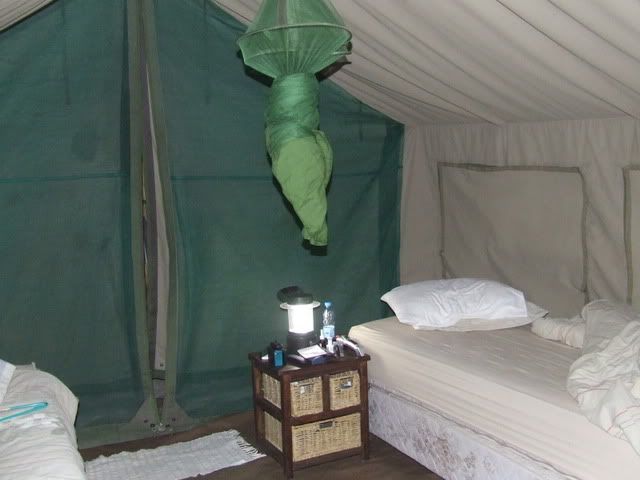 After a four hour “nap,†I arose and joined Vaughn and Patricia. He explained that he had come to awaken me, but that I had been sleeping too soundly. After some water, I suggested that we go check my rifles and get ready for the morning. He gathered up a box top, and we drove to a place away from camp and the river where there was a large termite mound. He set up the target, paced off about fifty paces and set up some shooting sticks. I proofed both rifles, and demonstrated an ability to put the bullets in the rifles, shoot both of them without hurting myself or others, and hit the target to boot. We returned to camp for dinner, which was very simple, but excellent. Sarrah, the cook, had been Patricia's primary cook in Patricia's restaurant, and Sarrah pointed out to Patricia that she need some items from the store. The following morning, we went out for our initial elephant hunting foray; however, after lunch, we went to town for groceries.  You hunt elephant on an elephant hunt. You don't shoot other species, so you must purchase food. We spent the afternoon shopping, and left with five shopping carts and two floats full. The back of the Land Cruiser was packed. Thereafter, we returned to the camp, arriving a little after dark. The next morning, we were back on the trail of Loxodonta Africana. This was the continuing pattern for the next nine days. We arose at 5:30am, got away about 6:30 to 7:00am, and hunted until lunch and then retired until about 3:00pm. One day, we took a lunch and stayed in the field, but rested for about an hour after lunch. Most everyday we saw sign and on most days we conducted a march to contact where Vaughn spent time glassing the herd to see if any really good bulls were present. After the first time being really close, I lost my natural nervousness about being so close to these huge animals. Vaughn pointed out a large bull with short, thick tusk. He explained that this bull would have heavier tusks than a younger bull with long ivory but because the young elephants have a larger nerve root. Although the long thin ivory is impressive, Vaughn wanted a large, fully mature bull with large, thick tusk. I want a elephant with long and thick tusk. This was a running joke with us for the rest of the hunt. In our driving we saw many animals including a monitor lizard. Vaughn and I both enjoyed birding, and saw many different species around the camp. 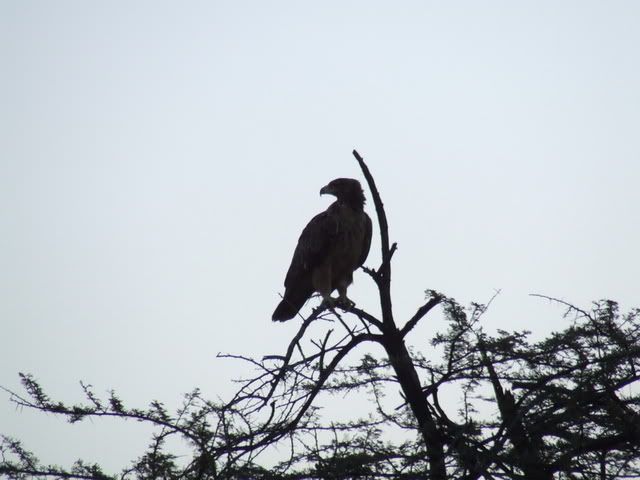 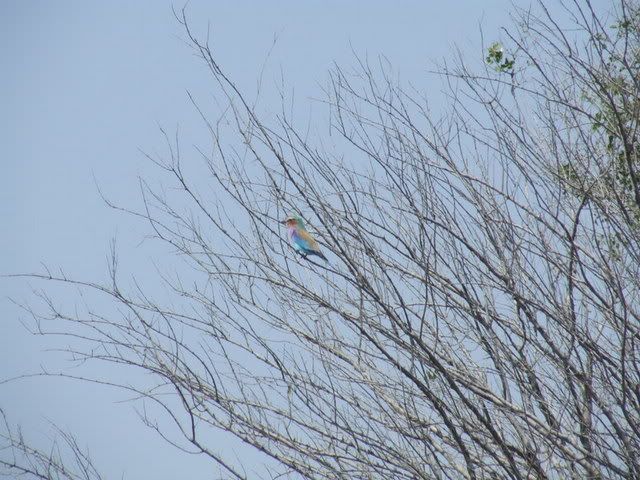 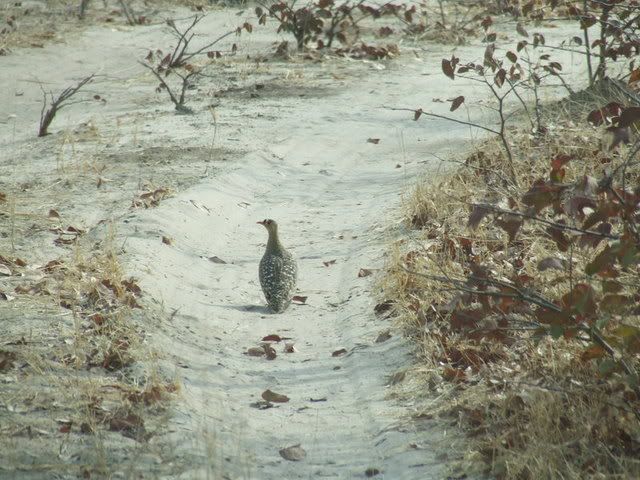 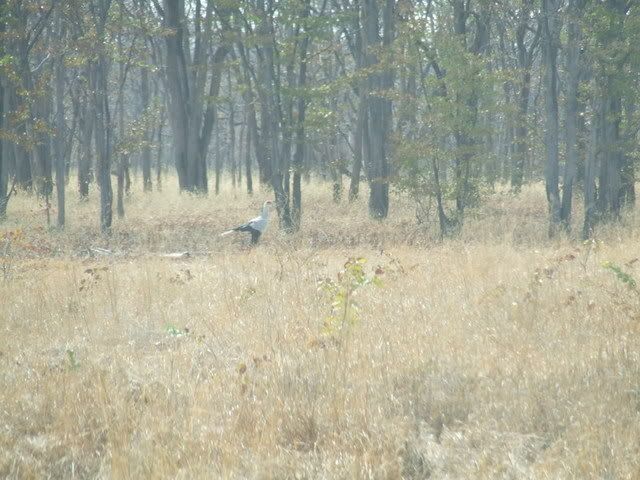 The second time we got into a herd, we closed with this group of what eventually turned out to be ten bull elephants. They were milling around in the shade of some trees that were on and around a series of old termite mounds. There were two young bulls with 25-30 pound ivory, about four bulls with noticeably larger ivory, two with impressive to me longer tusks, and two massive older bulls. One of these old boys had one tusk broken off, but the other was noticeably larger that the tusks of the younger elephants. The other old elephant had similarly large tusks, but one was worn badly and the other worn even more. Vaughn suggested that I shoot the large, fully mature bull with relatively short tusks. I thought about it and said we should give it a try because hunting it and taking it were two different things, and it would provide me experience. Although we gave it a good try, and followed this group as it left its noon-day resting place, we were unable to close with our quarry because of the fickle wind conditions. As I had said, wanting ain't getting, but it gave me added confidence being close to these giants. It is daunting to be as close as 30 yards from a group of animals who range in size from eight to ten tons. One must remember that most of the hunters who are killed and injured by elephants are not attacked by the elephant that they are pursuing, but one they stumble over or who stumbles over them. For this reason the entire party which included a game scout, conservancy representative, tracker, the ph, and me, were each alert to our surroundings, looking not only at the elephants we could see, but to our left and right and rear for the ones we could not see. On more than one occasion, we had to withdraw and re-close because of “flanking†movements by elephants in the herd. We were fortunate that most of the elephants with which we came in contact were bulls because it is the cows who are the most aggressive. On the two occasions when we encountered herds including cows, everyone was doubly vigilant and we moved away quickly from them as necessary to avoid contact or discovery. On the whole, familiarity does breed a degree of comfort, and after about the third encounter, I realized that my fellows had done this a number of times together and were very good at it. My task was to stay in my place in line and try not to hurt myself as I almost did the day I was adjusting some equipment and missed Vaughn's warning about a hole he stepped over. I was walking one moment, and the next I was hitting the ground as I stepped into a ground squirrel hole that had been enlarged by a wart hog or other animal. I was incredibly fortunate not to have hurt myself, but after checking my sundry parts found everything in working order. The remainder of the walk to the truck was enough to work it out. With the application of some Arnica Gel to the muscles for the next couple of nights, I had no ill effects. The weather was an issue while I was on my trip. A gale closed out my fishing trip early, and a strong headwind caused our in-flight emergency. These winds continued starting at sunset and growing until about the time we got to bed, the wind rattling the trees and the tents. African animals, like ours, don't like the wind, and it apparently impacted even the elephants movement. We had one day, after a particularly bad evening, when we did not find any tracks. The Salambala Conservancy is a huge area, and one needs to get into the elephants' heads to anticipate their movements, cut their tracks, and conduct a stalk. The wind concerned Vaughn because he could not anticipate their movements. Bobby Bowden, FSU's Football Coach, said that he'd rather be lucky than good. Although I believe luck favors the well prepared, like Bobby said, nothing can replace plain, old luck. On the day after we had struck out on finding tracks, we were checking out one of the main roads for signs and a young man ran down to the road from a group of dwellings to report he had seen elephant in the block we were along side while gathering firewood that morning. There was a discussion among Vaughn, the game scout and the tracker regarding what the elephant's most probable course of action would be, and we drove into the block searching for their sign. We found where they had crossed the track we were on, and got ready to pursue them. I took my rifle and Camelbak canteen, Vaughn took his CZ in 458 Winchester Magnum, and James, the tracker, his shooting sticks. Victor, the game scout, took an SKS with which he seemed familiar, and we all set off on the track at a quick pace. It took us over an hour to close with the elephants in part because during a stop, I stripped my outer shirt off, to get down to my T-shirt, and at a subsequent stop, realized that it had fallen out of my Camelbak pack. Victor, James and I went back along our path, and in about ten minutes Victor found the shirt. It took us another ten minutes to make it back to Vaughn, who had come back part of the way, and we all took off in search of the elephants again. It took us about fifteen minutes to catch up with them from that point; however, we spent at least an hour trying to close in and get a look at all of them. There were about twelve bulls in this group, some of which appeared to be some of the ones we had seen earlier, but with some new ones. Vaughn was excited about one who appeared to noticeably larger than the others. Many of these old bulls have askaris or soldiers who are younger bulls who shield these older bulls. It makes closing with and seeing old bulls difficult, and the really wily old bulls position themselves with regard to their flankers and other members of the herd so that it is very difficult, if not impossible, to close with them without the others picking up your scent. It is critical to see both tusks because so many of the older bulls have very worn or damaged tusks. Finally, Vaughn and I got a look at the bull's tusks, and indeed the other tusk was broken and somewhat shorter than the one we could see. Still Vaughn thought that he was the choice animal from this group. Before we could make a plan, the herd moved out forcing us to follow. This always presents problems because the animals spread out and graze as they move. Trying to stay with a particular animal is difficult, if not impossible. In addition, as noon approaches, the wind becomes fickle and can give you away. We stayed as close as we dared and paralleled their course down wind moving to our right. We stayed with the group, but lost our target bull in the shuffle. Victor caught our attention and indicated that he had heard elephants moving toward us, and suddenly, there was a terrific trumpeting and carrying on, as the two groups met and greeted one another. They milled around for a number of minutes and Vaughn was interested in one or two of the new comers. One of them was a dandy in my opinion, with long ivory that he would drape his trunk over; however, he was a younger elephant without the size of the big bulls we'd seen. Their smaller size can make their ivory seem longer and bigger, and the young bulls have more nerve and less dense ivory. While impressive, they may not be as heavy as they appear. After a while, the entire group started back the way our first group had come, and we reversed our field. We counter-marched almost back to where we had originally encountered the first herd. Vaughn worked his way in and glassed many of the bulls. Because of the wind, we had to pull out and move down back the way we'd just come. As we moved, we suddenly had an opening into the group and before us was the old bulls we'd been trying to catch up to. Vaughn discussed the other bulls with James, his tracker and purportedly an old poacher who knows many of the bulls, and decided to work in on this old one. He motioned me to follow him and load a round in the chamber. We moved parallel to them, and then toward them. Vaughn made some observations, and then we again moved parallel to them and again toward them. Vaughn motioned me and James to him, but up the sticks and asked if I could make the shot. There, 40 yards away, was the large old bull. Vaughn put his tusks just at 18-inches in circumference at the lip, and the broken one at 24 inches and the longer one at 30 inches. Ultimate weight would depend on how dense they were, but he felt certain that given his size and age, that his ivory would be dense. I had told Vaughn at the outset that I was not into flashy shots and wanted to make a fast, clean and safe kill. In sum, a heart lung shot would be preferred to a head shot. However, the heart-lung area of the bull was screened by a small tree between us and one of his Askaris was standing the other side of him such that the Askaris' tail, when he moved it, seemed to be coming out of the old bull's chest. I decided that I must take the head shot, which was clear. The elephant was almost broadside to me, with his head facing to my right. His ear hole and the temporal gland were both visible. I put my 416 on the sticks, slipped off the safety, and offered a prayer for a safe and merciful kill. At the shot, the back end of the elephant fell down and away from us, with the front part of his body following. He fell straight away from me, and the bottom of this chest and heart-lung area were exposed. Vaughn said to shoot him again, and I put two additional rounds into his heart-lung area. At this point, life got very interesting because at the shot, one of the elephants had run down wind, and now scented us. Vaughn told us to run, and James, Victor and I took off. I had been told to follow them, so I could not outdistance them, but I could keep pace with them, and I did. Soon, Vaughn was yelling for us to return. We had covered a good 25-30 yards by that time and I had reloaded my rifle. One advantage of at stock caddy for ammo becomes clear when you have to reload at a dead run. We turned, and ran back to Vaughn, who had run in the direction of the elephant who was down, but still trying to rise. As I reached him, Vaughn told me to shoot the bull again, and I hit him with a raking shot, the animal having rotated from his original position so that his head was away from our original position. Vaughn told me to run around and shoot him in the head. This time, I placed the bullet just right, and immediately the animal collapsed, tensed, and relaxed. Vaughn immediately congratulated me, and asked me why I was breathing so hard. I told him it was the wind sprints. 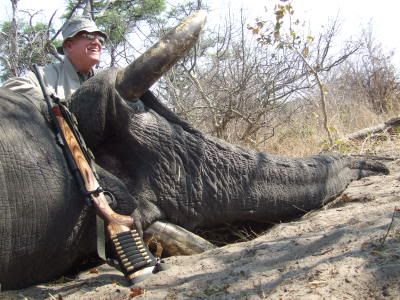 Vaughn checked the animal after a minute, and he was dead. I asked him to get my camera out of my pack and take some pictures. These reflect my fatigue, my relief and my sadness mixed with joy at my success. There is always a since of loss when one kills an animal which is balanced intellectually by the knowledge that death is a part of life and necessary to the balance of life. I would see the next morning the joy on the faces of the people who came to get a portion of this animal's flesh to feed themselves and their families. Their joy was unfeigned as they patiently waited their opportunity to take their share away. The amount of meat was incredible, as they stripped the carcass.  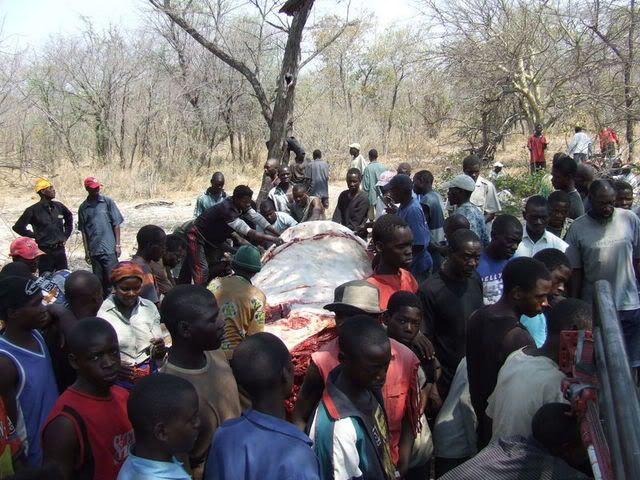 My first shot had been two inches too far forward. It was not totally incapacitating, necessitating the follow up shots. One or more of the heart shots had connected home, and had he been able to regain his feet, he would not have gone far. The last shot, had been what I had wanted the first shot to be, however, from first shot to last could not have taken more than a minute or possibly two. 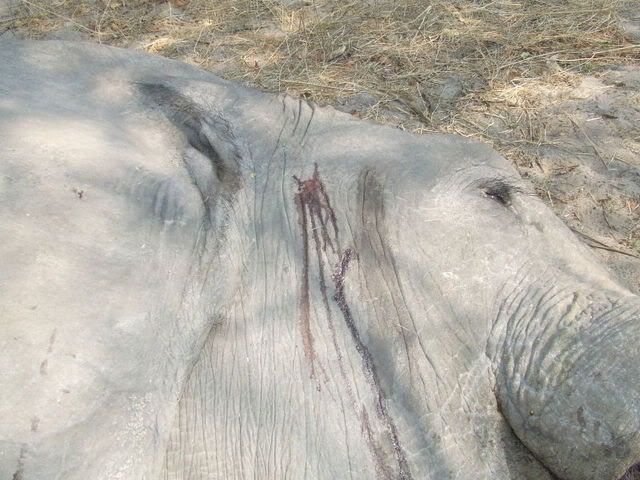 The bull was estimated to be 45 years old. His weight was approximately 11,000 pounds. The weight of his ivory is not yet known. His tusks were 18†in circumference at the lip, the short tusk was 24†and the long 30â€. I am told that elephants in this area typically break their tusks digging for water and “rooting†at trees which is why old bulls with long tusks are a rarity. 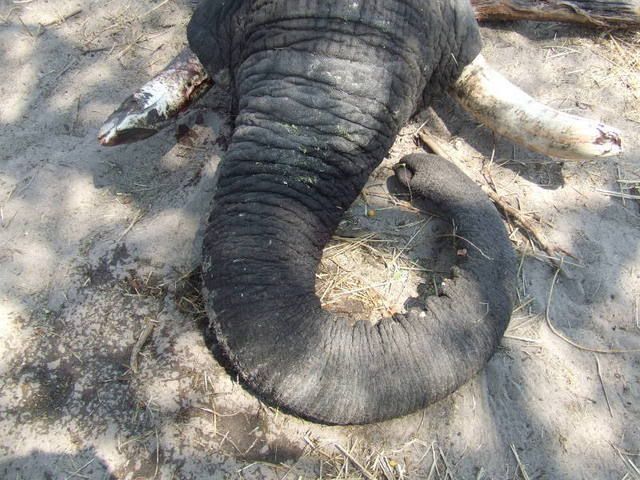 My good friend, Steve Malinverni, asked what is a “nice†elephant. It is a representative animal in the area that you are hunting which you've “earned.†My bull will be better than many and perhaps not as good as some that will be taken in Salambala this year. He was an old animal, at the close of his breeding life if he had not already reached it. In sum, he was a worthy old bull which was what I sought. The taking of his life provided needed meat to the surrounding community. Not an inconsiderable amount of the money I paid in daily fees was spent in the community for food and gas and to secure the hunting rights in the conservancy. The trophy fee went to support the conservation activities of the conservancy and provide some money to the people living in the area. The old bull gave of himself not only to our community, but to his too. The day following, we got up early, and I began to back to return to Windhoek. We drove to the area and cut a road into the elephant. Trophy photos were made, and the butchering of the elephant began. The elephant's head was severed and taken to the camp, where it will be stripped of flesh, then buried to facilitate the removal of the tusks. We returned to the camp, had a late lunch, and I made ready to leave. I thanked the folks in the camp, gave them a bit of money, and Vaughn and I raced to the airport to catch the Monday flight to Windhoek. We barely made it, but I was soon on a Beechcraft King Air headed for Windhoek. 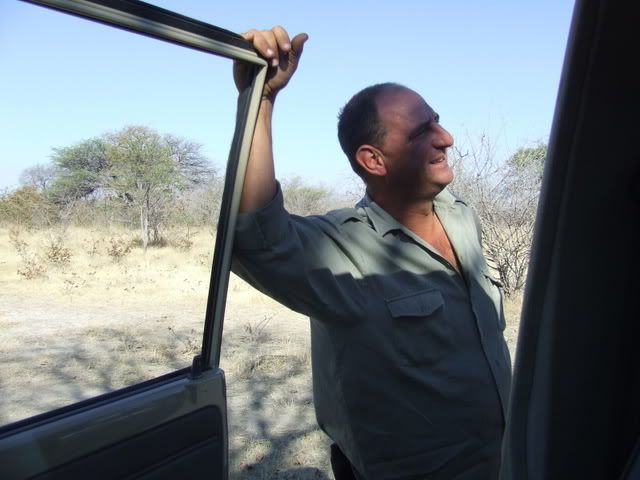 This time, as the sun set, I could look back on a full week of rich experiences. I had found a real friend in Vaughn, who I felt I'd known all my life. His wife and mine share the same names. We both like our beer and an occasional single malt. We both have similar (and weird) senses of humor. We have a similar appreciation for wild life and conservation. I really appreciate what he is trying to build at Salambala, which is to grow a vibrant wild animal population recovering from the rampant poaching that accompanied the bush war fought in the area. I looked forward to a dinner at Joe's Beer House, seeing Patricia and Gert again, and planning the next phase of my quest: damara dik dik and greater southern kudu. Gert had arranged for us to stay and hunt on Farm Ruppell which is located on the way to Swakopmund near Omaruru. The morning after dinner at Joe's with Patricia, Gert and Patricia's sister, Sonya, Gert picked me up at the Safari Court and Hotel and we drove three hours to Farm Ruppell where we would be hosted by the Van Rensbergs. We arrived there in the afternoon, and after what the Brits would call “Tea,†we settled in and checked the zero on the rifles. Gert was fascinated with my collection of odd ball cartridges, but I shot better at Farm Ruppell than I had at Salambala. My first two shots at 100 yards from the 425 were within an inch of one another from a rest on the hood of the car. I only fired one shot with the 416, after all, what can go wrong with express sights? That shot, fired off-hand, was a half inch away from the center and right on up and down from 50 yards. We returned to the house, had a Tafel Lager, and waited for dinner which was not long in coming. The primary cook as Mrs. Van Rensberg, Petro, pronounced “Pay-true,†who produced wonderful traditional Afrikaans dishes that were incredibly hearty and good. She was help by her daughter, Lisna, and her first cousin, Thilisa, who were both 17 years of age and entering their senior year, but home on holiday. I gathered that their school system mirrors ours with 12 grades. Lisna's twin brother, Berant, would be our guide on our hunt. Jan, their father, was primarily engaged in operating the ranch which raised cattle, sheep and goats. Everyone wanted to know about the elephant hunt at dinner, and we stayed up longer than we might have before retiring to very comfortable rooms and excellent beds. We had a wonderful breakfast, and started our hunt on Farm Ruppell for dik dik and kudu. The farm is dominated by several huge granite rocks, rising out of the relatively flat landscape like Stone Mountain in Georgia. We generally started our day by climbing one or more of these and glassing the area for animals. I learned right away that we had a prince in Berant, whose eyes were incredibly sharp. We hunted for both dik dik and kudu and did not know when we might come across either. It was decided that I would carry the 416, because it would be quicker than the 425 Express if I came on a dik dik, and Gert would carry my 425 which he could use to back me up or change with me if I needed to make a longer shot. Our first day, the wind worked to our disadvantage and we had no opportunities. The second day was much like the first. The third, we drove over to this rock where everyone agreed the dik dik were always around. We pulled up, got out, and Gert told me that there were always dik dik in this area. He had not gotten the words out of his mouth, as we crawled under a fence, when Berant said, “There is one right now.†We started up the rock in order to gain a height advantage, and moved away from the road. We had not gone 25 yards, when Berant point out the dik dik. I settled into a good seated position, which isn't all that easy on a large piece of granite. Before I could get settled, the dik dik determined he had been seen and took off again, running almost straight away from us. This time he stopped about 100 yards away from us. I asked Gert to change rifles with me. I settled the 425 down on the little animal and let fly a 400gr Barnes Solid. The dik dik immediately went down, and thrashed a short moment and was still. The shot was exactly where I had aimed, just behind the front legs, and the huge bullet had punched a .425†hole in both sides of his small hide. We put the little animal in the cool box and went to the farm, where Gert spent a good part of the afternoon skinning out the little animal. He did a very good job, and I asked about this skill. He had studied at one time taxidermy, and had learned skinning. It showed. Gert measured the little trophy, but could not remember the length later on. He did say at the time that it was the equivalent of shooting a 64†kudu. This too was an old bull, who was being pushed out of his territory by a younger male, who we saw with a female.  We now began to concentrate on the kudu. I would carry the 425, and Gert his 7mmRemMag. We had seen nothing but cows and small bulls, nothing that would really qualify as a trophy animal. We hunted hard two more days, and we were at our last day. Jan, Berant and Gert got their heads together and concluded that this was the time when the kudu bulls like to go over to place on the Jacobus' farm next door. Gert, who had worked in this area and knew most of the farmers in the area, called Herr Jacobus and cleared hunting their farm the last day. We arose and drove over to their farm after breakfast. We started out hunt with Gert taking us to a rise and searching the surrounding area. We also checked the roads as we moved about for signs of kudu moving. The second time we changed our observation point, Berant saw a fine old bull off in the distance. Gert estimated the range to the animal to be about 500 yards, and we began a stalk. For the first 200-300 yards, we were moving down hill towards the animal, and were largely shielded by the arcacia trees. However, the last 100 yards was tough going because the animal, a terrific old bull, was looking right at us. Finally, we duck walked five yards to a arcacia, and Gert, who was in the lead, described the set up. The kudu bull was a bit over 100 yards away and looking directly at us, with head to his right, our left and his body angled to his left or our right. Only his head, neck and apiece of his shoulder could be seen. His body was obscured by a tree he was standing behind. I stood and took aim off-hand at a point where his body had to be and to our right of his neck which should place the bullet in his body. I fired, and he took off running to our right. I saw him running, and ran around the arcacia we were behind and forward to try and get an open shot at him. Meanwhile, Gert was calling for me to come to him. While I was getting around the tree, the kudu had reversed himself, and gone to ground about 100 yards away. I ran to Gert, and this time I could see a large portion of the kudu's body. I took aim at his off-side shoulder, and fired. He collapsed immediately. We ran quickly to him, and I put a round in his spine, between his shoulders to finish him. 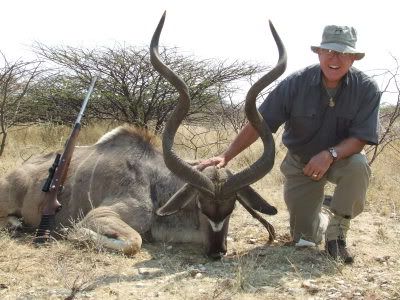 He was as Gert had observed a huge, old bull. His horns were 57.5â€, and were 17†at the base. Clearly, he had been longer in his prime, but had worn his horns down. From his teeth and this general condition, it appeared that his bull was looking at his last summer, and would not have made it through he approaching dry season. We waited as Gert drove the truck to us; took some trophy photos; and loaded the animal on to the truck. We took him to the Jacobus' farm where the bull was caped for a shoulder mount. In cleaning him, two of the three 350gr Barnes X bullets were found. The second bullet fired fully penetrated him, having hit him behind the left ribs and exiting the right shoulder. The last bullet was recovered in his chest and was fully mushroomed. The other was the first round fired, and it was recovered in the off-side hindquarter. 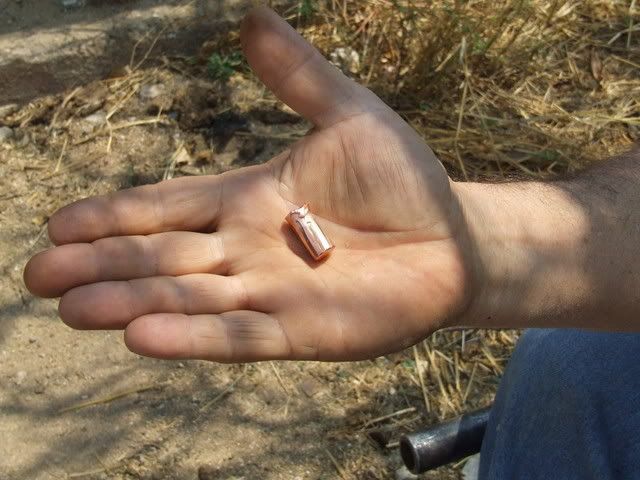 It was 10:30am of my last hunting day. I had hunted hard since the 19th, having lost a day when the charter diverted. In the 15 days available to me, I had taken a gigantic old elephant bull, an old dik dik bull that was spectacular, and now a kudu bull to write home about. I was thrilled by the success and the good time I had had. My trip was nearly five vacations in one. The first was the day in Germany. The second was the tour of the coast and fishing. The third was a detour into Botswanna. The fourth was the elephant hunt. And the last was the hunt for the dik dik and kudu. It had been an eventful time, and now is was time to go home. I had had a wonderful time and learned some new lessons. I would recommend Namibia as a hunting destination now even more than before. In fact, it may have displaced RSA has my recommendation for a first African hunt. Vaughn Fulton's Classic Safaris is a first class outfit, and he is a man of character I really respect as a man and a ph. Lessons Learned: 1.Be careful of charters. Don't fly if the plane's capabilities do not meet the mission. Don't put heavy equipment, especially gun cases, in the cabin where they can become missiles in a crash. Stay interested in the details of the flight. And be assertive. 2.Get in good shape for your hunt and shoot a lot. 3.Study the animals and know their anatomy, and where to shoot them. 4.Pay particular attention to the weather and the latest reports. Adjust your clothing accordingly. 5.Pack lighter. 6.Enjoy the people and the moment. 7.Let your ph know what your ideas are on trophy quality. 8.Ask nicely for changes if they are necessary for your comfort. 9.Learn to say thank you and good morning in the native language and say it. 10.Make a will and estate plan if appropriate before you leave. | ||
|
| one of us |
What a story! Driving a Corolla on the wrong side of the road was enough travel danger for me. And what a fabulous kudu. Congratulations all around. JF | |||
|
one of us |
That was an excellent, detailed report. Thanks for that and the pictures as well. Congratulations on your trophies. ------------------------------- Some Pictures from Namibia Some Pictures from Zimbabwe An Elephant Story | |||
|
| One of Us |
Great report and photos! Thanks for sharing your trip with us. | |||
|
| one of us |
Nice report, you could have put a little detail in it though. Just kidding, great report. Frank "I don't know what there is about buffalo that frightens me so.....He looks like he hates you personally. He looks like you owe him money." - Robert Ruark, Horn of the Hunter, 1953 NRA Life, SAF Life, CRPA Life, DRSS lite | |||
|
| one of us |
Congrats on a great experience! Isn't that what an African trip should be? "There always seems to be a big market for making the clear, complex." | |||
|
| One of Us |
Kudude, Congratulations!! Steve "He wins the most, who honour saves. Success is not the test." Ryan "Those who vote decide nothing. Those who count the vote decide everything." Stalin Tanzania 06 Argentina08 Argentina Australia06 Argentina 07 Namibia Arnhemland10 Belize2011 Moz04 Moz 09 | |||
|
| one of us |
Awesome hunt and report, thanks for posting. I wouldn't be at all concerned about the weight of the tusks, an old bull like him has tons of character and is a great trophy. Congrat's! | |||
|
One of Us |
Kudude, fantastic old bull character to say the least...Elephant hunter welcome home... Mike | |||
|
| One of Us |
Excellent hunt report and some great trophies! Its really amazing to see all the locals show up to share the meat! Thanks. Steve(NOT Shakari)Robinson NRA Life Member SCI Life Member DRSS | |||
|
| One of Us |
Sounds like you had a great time in Namibia. That Homeopathy "Arnica" is great stuff for strains, bruises and grazes, hey. PS, love those old bulls. ozhunter | |||
|
| one of us |
Great report kudude. Thanks for sharing all the detail. Your bush plane story scares the heck out of me. Congrats on the elephant and the awesome kudu. Welcome home, and I'm glad you're safe. ______________________________ "Truth is the daughter of time." Francis Bacon | |||
|
one of us |
Great report and photos. That's a tremendous kudu. Congratulations on the whole safari. Kyler | |||
|
| One of Us |
Thank you sir for the story of your hunt. It certainly helps to fuel my dreams! SFC E7 "Ain't as long as it has been, ain't as short as it's gonna get". | |||
|
| One Of Us |
What an adventure. I'm glad that your trip was a great success, despite the scary moments! | |||
|
| One of Us |
Congratulation and thank you for sharing your safari with us. | |||
|
| one of us |
Congratulations on a tremendous hunt. | |||
|
| One of Us |
Great report, Kudude, it reads like a book. I was particularly "puckered up" with your flying story and that pilot was an idiot. That was great headwork on yor part to keep a plot with your GPS, it probably saved your life. IF as you say, the airplane was VFR only capable, he was totally clueless and his situational awareness was worthless. Glad everythig turned out though. Great report. jorge USN (ret) DRSS Verney-Carron 450NE Cogswell & Harrison 375 Fl NE Sabatti Big Five 375 FL Magnum NE DSC Life Member NRA Life Member | |||
|
| One of Us |
Congratulations on a geat safari! ____________________________________________ "Build a man a fire, and he'll be warm for a day. Set a man on fire, and he'll be warm for the rest of his life." Terry Pratchett. | |||
|
| One of Us |
Congrats and thanks for the report and pics. You can borrow money, but you can't borrow time. Don't wait, go now. Savannah Safaris Namibia Otjitambi Trails & Safaris DRSS NRA SCI DSC TSRA TMPA | |||
|
| one of us |
Thanks for the very enjoyable Saturday morning reading. Its nice to hear about Vaughn and his operation also. Having recently flown in and out of Maun I could easily visualize your low fuel in high wind adventure. That area is crawling with cats and would not be a good place for a plane wreck. ALLEN W. JOHNSON - DRSS Into my heart on air that kills From yon far country blows: What are those blue remembered hills, What spires, what farms are those? That is the land of lost content, I see it shining plain, The happy highways where I went And cannot come again. A. E. Housman | |||
|
| One of Us |
Great old bull, kudude. You must be a pilot, no? From your story, I can see how that might come in handy, sometimes. Ignorance is not always bliss. Congrats! Mike Wilderness is my cathedral, and hunting is my prayer. | |||
|
One of Us |
| |||
|
| one of us |
Kudude, Congratulations on your hunt and nice trophies. Hamdeni  | |||
|
| One of Us |
Wonderful story and great pics. Thanks. I'm curious about your reason for avoiding Dulles airport. I was concerned about flying out of there with firearms so I contacted the airport manager, who I learned was a retired Army LTC, and asked a few questions. It turns out he's pro-hunter and insisted I share a few post hunt photos when I returned. My experience at the airport was smooth with check-in as per regulations and airline policy. | |||
|
| One of Us |
Thank you very much for the nice words and wishes. I am indeed glad to be back. I will let you know about the ivory when I hear. Please note the offer by Classic Safaris through Wendell Reich of the similar elephant hunt being offered. It is a really good deal. A couple of replies: I once learned to fly and soloed, but gave it up during a major life change. In the service, I did learn and teach map reading and land navigation. Doing in the air just gives one better visibility of terrain features. The advent of the GPS almost takes all the fun out of it (I thought!) I avoided Dulles not because I feared problems there. To get from Tallahassee to Dulles I would have had to change planes at least once and possibly twice before checking my bags for the African leg of the trip. I feel that if you cannot check your bags and firearms on your initial flight to your final destination, your chances of having problems increase greatly. Most of the people I know who have arrived in Africa minus their ammo or weapons or both, have flown XYZ Airline to New York, Chicago, et., and then boarded their African flight. My first trip, we flew from Miami, and I remember calling one of the regional carriers about flying from Tallahassee to Miami. I ask the young woman about carry firearms, and it was immediately obvious that she was clueless. Since then, I have driven to my point of aerial departure and checked my firearms through to my final destination. This has worked through nine trips without a hitch. Further, I have also experienced the trip from Joburg thru the Azores to Atlanta, which was a very long flight on a 747. It has got to be awful on an Airbus. The Frankfurt routing let me break the journey into two more manageable legs, rather than one very long one. In addition, I avoided totally the RSA gun transfer problem. I hope that explains my rationale and offers some insight into my planning. Kudude | |||
|
| one of us |
Great report Kudude!! Especially appreciated your comments of respect regarding the elephant bull after he was on the ground. This is a part of hunting important to me and not discussed enough by many of us. Congratulations on a great trip. Phil | |||
|
| One of Us |
If I may respond about using Dulles as a departure airport: Departing- well. last trip I had a three hour layover and the bags did not make it to the plane, costing me a trip back to Jo-Burg the next day to pick up baggage But The real issue is returning to the US. When arriving, one exits the plane, then walks a jetway to the bus, which takes one to the customs area. Last trip, the bus waited 20 minutes before departing, because two ladies were walking with small children very slowly, and one lady was very ill and slow in a wheelchair. Upon arriving and clearing passport control, I have been told both times coming in to Dulles, that firearms will be offloaded last. Both times the entire plane had picked up baggage and cleared customs before any firearms were brought up. TSA opens and inspects every firearm case once you clear customs and recheck baggage, which takes quite a while. Also, one needs to board a shuttle bus to carry on to one's departure, unless, by chance, your connecting flight is in the same terminal as customs. Really slow- took us 2 1/2 hours to clear: 1. Late/slow bus to passport control 2. Long wait for rifles- this is the biggest issue 3. Long wait for each rifle to be inspected by customs 4. Long wait for TSA to check before accepting 5. Another bus ride to connecting flight ______________________________ "Are you gonna pull them pistols,...or whistle Dixie??" Josie Wales 1866 | |||
|
| one of us |
Excellent report and a grand, old man in that elephant bull! I love the character in those tusks and agree wholeheartedly in the statement that a trophy is not defined in inches or pounds! Congratulations on a true adventure. On the plains of hesitation lie the bleached bones of ten thousand, who on the dawn of victory lay down their weary heads resting, and there resting, died. If you can talk with crowds and keep your virtue, Or walk with Kings - nor lose the common touch... Yours is the Earth and everything that's in it, And - which is more - you'll be a Man, my son! - Rudyard Kipling Life grows grim without senseless indulgence. | |||
|
| one of us |
Thank you Kudude for the explanation about nice I had a wrong idea about the word nice, I always believed that it has a meaning more near to gracious or charming, something that I could define "feminine" and it was difficult for me associate a elephant bull to the word nice. OK I learned something new. Another time I have been helped in broadening my knowledge or the meaning of words and concepts. An old Austrian hunter, owner of a hunting & gun shop, found me admiring his red deer trophies. There were two or three gold medals, but there were one of the trophies, probably a silver medal, that keeped my attention because the shape, like a heart. Even if it is not considered the best, I always preferred this kind of shape. And that trophy had all the characteristic that I like, dark, very dark, near to black, that normally means a hight density trophy and consequently a good weight and quality, with a lot of pearls, very regular. Well, the old hunter asked my opinion about that trophy and I answered that I like it a lot and that for me that it was really fine. He looked me for a pair of seconds and then roared that the trophy was not fine, but good! With that roar he broadened me the concepts to judge and define the trophies in Austria. bye Stefano Waidmannsheil | |||
|
| One of Us |
Finaly got the unofficial weight on my elephant: it was 44# and 48#, which will put in in the silver medal range, having missed the magic 100# by about 10#. It is still a "nice" elephant and mine! Kudude | |||
|
| One of Us |
Kudude, thanks for your time and effort to bring us pictures and hunt details. It puts the prospective hunter right there with you on the trail. I tried to walk in your footsteps a little bit. I went to Namibia for a three-week hunting vacation with Classic Safaris. As you pointed out, you never know what to expect. I did not expect to sacrifice a week to illness, but that's what happened. As it happened I did have enough medicine along to treat the problem, but it was a slow recovery process. I had to charter out of the hunt area (Etosha camp near Hobatere) and spend 6 days in a Windhoek Hotel on my back. Once I was clear of the infection I was off again. I did get to hunt Salambala Concervancy and Kasika Conservancy. My luck was not excellent there either. I did get an elephant though. We hunted hard, but it was as if the elephants knew we were after them. I saw 5 elephants in Salambala that week. My PH (Nick Nolte) and I concluded that a lot of the elephant population might be staying in nearby Chobe Park in Botswana. I also did not get to Kasika at the ideal time. Once again, my hunt there occurred when the bull elephant population was in Botswana. The buffalo popultion was also in Botswana, but we could see them just across the Chobe River. During that week I did not run into plains game. Only 2 impala and a duiker. I suspect the reason for that is the many native villages springing up everywhere. Had I been there at another time, of course the situation could easily have been the reverse. I have heard that there have been times that the area has been covered up with elephants. One other luck related problem -- an unhappy hunter in camp with me. I discovered that a hunter with personality problem and a bad attitude will try to make everyone else as miserable as they feel. I just did my best to avoid this unfortunate human being. I am sure Vaughan had to deal with trouble generated by this guy on a daily basis. What's the good news? The .416 Remington with 400 grain trophy bonded sledgehammer worked well as usual. One moving 150 yard dusk shot to the heart/lungs was all it took to put the tusker on the ground. He was unconscious when we caught up with him. I also brought 350 grain Barnes-X Triple shock. I used it on an ancient giraffe at the Etosha Camp. Once again the initial heart shot was lethal. I looked at a picture of giraffe anatomy before the hunt, so I knew exactly where to aim. One note about the Triple shock. It is extremely accurate in my gun (much to my surprise). I was shooting the giraffe at one hundred yards. The initial round plus the follow-up parting shot were revovered. Both lost all petals. The round certainly did kill well, but was torn up pretty badly in the process. I expected to see at least one round mushroom. This leaves me with the impression that the 350 grain Triple shock is adequate for giraffe, but maybe not better than adequate. In the final analysis I concluded that Hert (the PH) was right when he said that if you are after giraffe it is wise to take along the ammunition you would normally use for cape buffalo. I think using 400 grain Barnes-X on giraffe might be a better way to go. The heavier, slower bullet probably would give better performance. I found Namibia to be a "sleepy" country, somewhat like a throw-back to former times in colonial Africa. English was the common language. It certainly was hot in October, but that should not discourage people from going hunting late in the year. The flights were long but did not pose a problem. Government red tape was minimal and very reasonable. All the natives had a smile and a great attitude. Happy hunting, Kudude. Thanks for telling your story so well. Talk to you later. That which is not impossible is compulsory | |||
|
one of us |
Are you going to post a full report and pictures from your trip? Edit: Sorry to hear about your illness. Was it something you contracted locally? ------------------------------- Some Pictures from Namibia Some Pictures from Zimbabwe An Elephant Story | |||
|
| One of Us |
I would like to thank everyone who avoids Dulles as their departure point. It helps keep the trafic down. I have started all of my Safari travel from there except one and have never had a problem, maybe just lucky. | |||
|
| One of Us |
"One note about the Triple shock. It is extremely accurate in my gun (much to my surprise). I was shooting the giraffe at one hundred yards. The initial round plus the follow-up parting shot were revovered. Both lost all petals. The round certainly did kill well, but was torn up pretty badly in the process. I expected to see at least one round mushroom. This leaves me with the impression that the 350 grain Triple shock is adequate for giraffe, but maybe not better than adequate. In the final analysis I concluded that Hert (the PH) was right when he said that if you are after giraffe it is wise to take along the ammunition you would normally use for cape buffalo. I think using 400 grain Barnes-X on giraffe might be a better way to go. The heavier, slower bullet probably would give better performance." Here is a further speculation about bullet performance: My impression is that the original Barnes-X is a tougher bullet than the Triple Shock. I suspect that Barnes re-engineered the copper alloy in order to make it expand faster, and in the process it has given us a round that is no longer as reliable on dangerous and heavy game. My loads are producing a muzzle velocity of 2660 for the 350 grain Triple Shock in my .416 Remington. In defense of the Triple Shock, that kind of speed of course will put any bullet to the test because at such speeds the impact will be violent even at 100 yards. On the other hand I have had many years of experience with the original Barnes-X. My observations of the triple shock are limited at this early stage, but I cannot help thinking that the regular Barnes-X would have mushroomed well and lost almost no weight on those two shots at the giraffe. I am now concluding that if I stay with the current muzzle velocity, then heavy African game may require that I load with the original Barnes-X for peak downrange performance. I'd like to know if others have made similar observations. That which is not impossible is compulsory | |||
|
| One of Us |
Bill, I have not tried the Triple Shock because the original Barnes X performs so good. I took my Giraffe at about 70 yds with 225 gr X in 338 WM. It was one shot and he walked about 50 yds and piled up. I am setting here and the remains of the bullet are in front of me with one petal left. I use to try different bullets but for Africa it is Barnes X and solids. | |||
|
| One of Us |
Great report and fantastic pictures! | |||
|
| One of Us |
Bravo! What a great hunt! Brian "If you can't go all out, don't go..." | |||
|
| One of Us |
Great story, great hunt, and a fabulous kudu. Advice from an old African bush pilot: Avoid short-range, single engined, gasoline-powered aircraft in Africa, anywhere in Africa, if at all possible, if you want to live to a ripe old age. | |||
|
| Powered by Social Strata |
| Please Wait. Your request is being processed... |
|
 The Accurate Reloading Forums
The Accurate Reloading Forums  THE ACCURATE RELOADING.COM FORUMS
THE ACCURATE RELOADING.COM FORUMS  Hunting
Hunting  Hunting Reports - Africa
Hunting Reports - Africa  Namibia, Vaughn Fulton's Classic Safari's Elephant Hunt
Namibia, Vaughn Fulton's Classic Safari's Elephant Hunt

Visit our on-line store for AR Memorabilia

